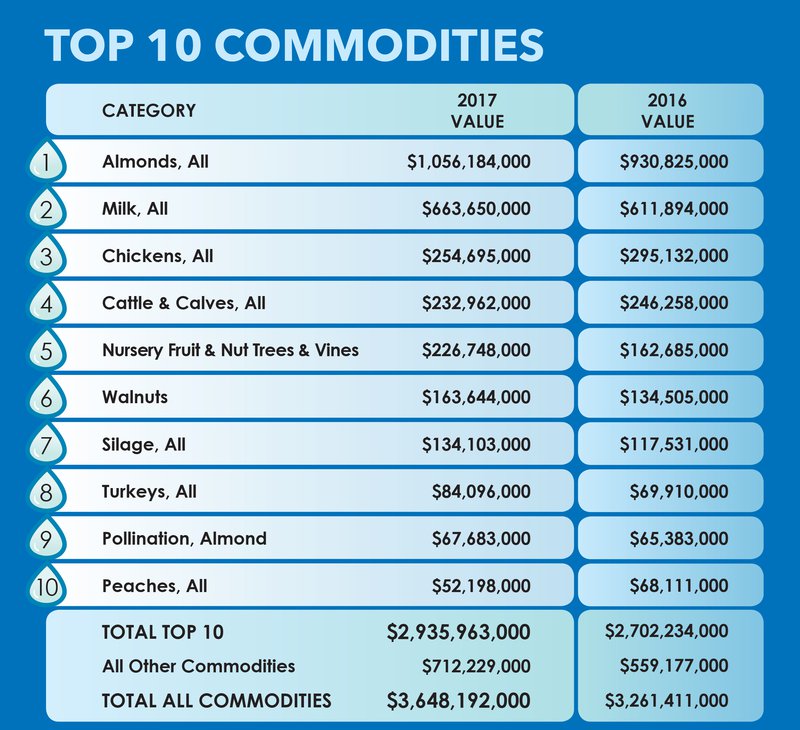The Stanislaus County Agricultural Report of 2017 not only highlights the impact that agriculture has on the local economy, but it also emphasizes the importance of water.
According to the 2017 Agricultural Report, the value of agricultural commodities produced last year in Stanislaus County increased by 12 percent to $3.6 billion — that’s $386 million more than the 2016 report of $3.2 billion.
“Although Stanislaus County produces over 230 different commodities, the top ten commodities alone represent 80 percent of the county’s total production value. When combined with all other commodities produced in our county, Stanislaus County’s agricultural value ranks higher than 20 different states’ ag values,” said Amy Lomeli of the agricultural commissioner’s office.

Almonds, organic commodities, nursery, milk, walnuts and vegetables all experienced significant increases in total value in 2017. Almonds posted the largest increase at $125 million with more harvested acres and higher yields, followed by organic products at $99 million which is attributed to higher prices and more organic producers in the county.
The number one crop of almonds at $1.1 billion also saw an increase of 6,000 more production acres in the county in 2017.
“An increase in yield and an increase in price, almonds dominated the top ten crops in increased value and remains Stanislaus County’s number one crop,” said Richard Homer of the Stanislaus County Agricultural Commissioner’s Office.
Almonds have been the county’s top crop since dethroning milk in 2013. The dairy product has remained in second place over the past four years.
Milk once again came in second place in 2017 with a value of $663 million, up from 2016’s value of $611 million.
“With less than a 2 percent change in production, it was the 10 percent increase in market milk price and 8.5 percent increase in manufacturing milk price that caused the increase of the total value of milk,” said Homer.
Although ranked sixth on the top crops list at $164 million, walnuts saw an increase of $29 million in 2017.
“Walnuts had a slight increase in acres, a slight decrease in yield, but it was the increase of almost $500 per ton in price that caused this category to have such a large jump in value,” said Homer.
Substantial decreases in the value of peaches (#10) and chickens (#3) were also noted.
Harvested acres increased by more than 18,000 as plantings continued to rebound from the drought that ended in 2015.
Stanislaus County Agricultural Commissioner Milton O’Haire said that recent rebounds in agricultural commodities could be short-lived, however, if the State Water Resources Control Board implements its plan to mandate 40 percent of unimpaired flows along the lower San Joaquin River and its tributaries be released to help rehabilitate the area’s native fish species.
“It could be said that of the three major natural resources required to farm, water is the most important. A crop, although it might be limited, can be produced in poor soils and unfavorable weather conditions, but nothing will be grown without water,” said O’Haire to the Stanislaus County Board of Supervisors. “The development of the irrigation systems has transformed the landscape from large acreage wheat farms into a strong agricultural based economy producing hundreds of different crops. The agricultural industry now supports over 35 percent of the jobs in the county. In a sense, our economy is based on water as much as it is based on agriculture.
“Agricultural values are on the rise again after several years of decline. Although we have yet to equal our all-time high of $4.4 billion in 2014, if the water supply is interrupted to the extent that is being proposed by the state water board it is likely we would never see these types of values again,” said O’Haire in his final remarks to the Board of Supervisors.





